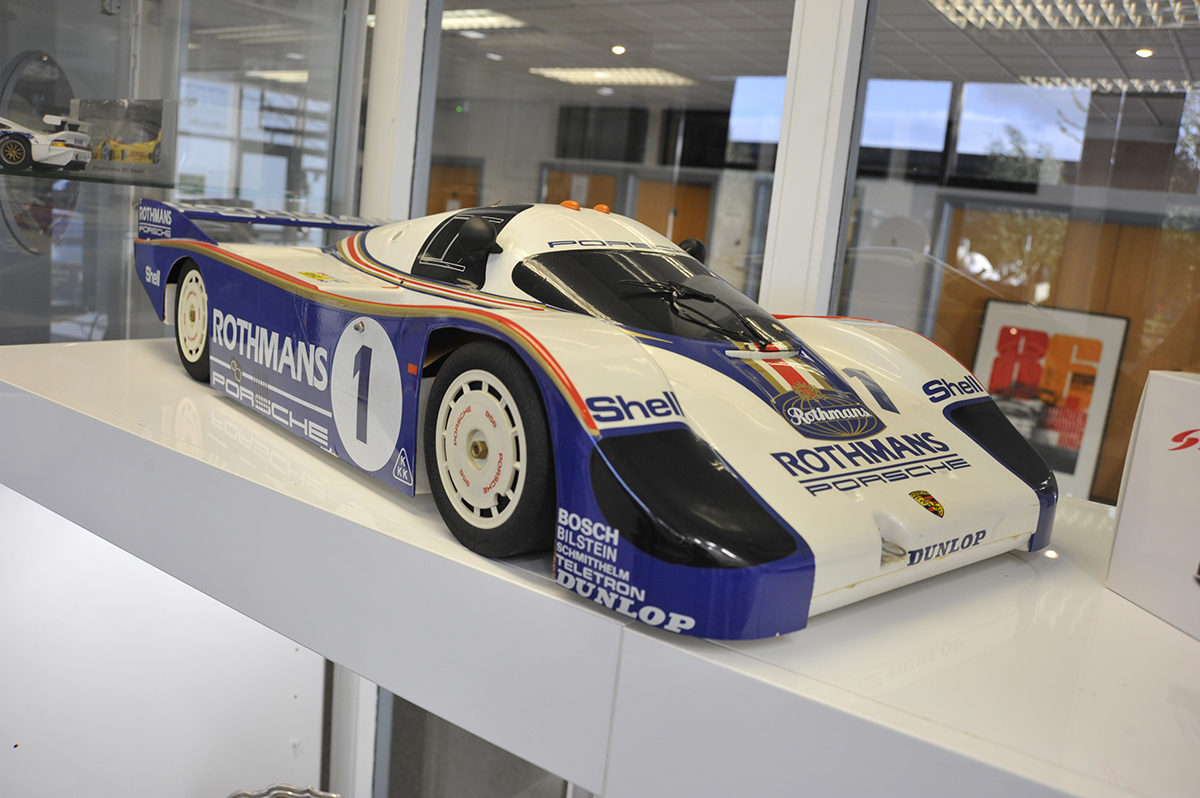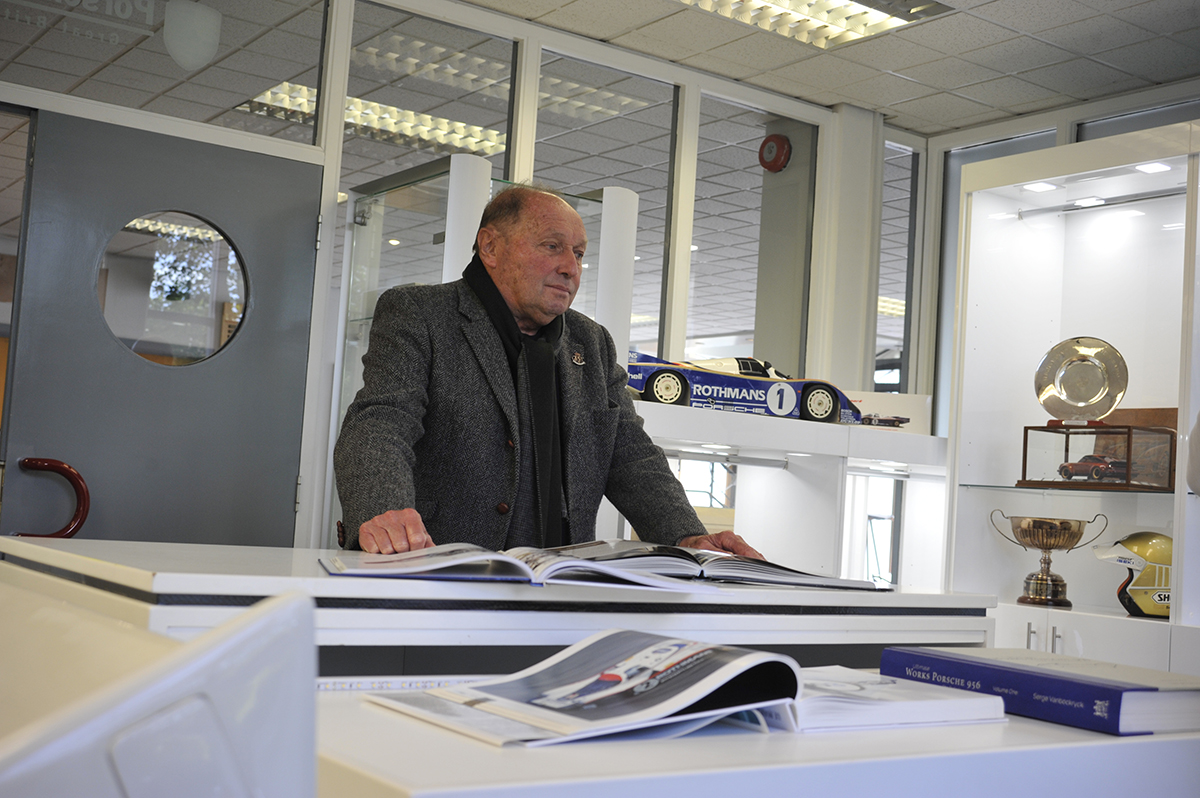Porsche’s partnership with Rothmans coincided with the marque’s most successful era in motorsport. Forty years since its genesis, the Club is incredibly lucky to count two of the most pivotal players from the period as friends. Richard Watling, now Vice Chair at PCGB, and Jochen Mass, lead driver for the 956 works cars, met recently at Cornbury House to reflect on an extraordinary and unrepeatable decade in sports car racing.
Watling and Mass first met in the early 1980s when Rothmans, for whom Watling worked as Head of International Marketing Services, began sponsoring the March 821 in Formula 1. It was an uncompetitive car, and Watling remembers the straight-talking German questioning the wisdom of Rothmans entering F1 at all, before suggesting they consider the newly announced Group C instead.

“I said I didn’t even know what Group C was,” Watling admits, “so you told me about it and said that Porsche had built a new car that was going to be a world-beater. Then you introduced me to Manfred Janke and within days I was in Stuttgart, meeting Peter Schutz, Helmuth Bott and Ferry Porsche. We all got on so well, which is what really started it all; the chemistry was very good.”
Having navigated the complex internal politics of Rothmans’ parent company, Watling was able to secure an agreement for Porsche in the summer of 1981 with the 956 ready for its debut at the 6 Hours of Silverstone the following May. “That first season was very good,” Mass recalls. “The mood in the team was fantastic and the car was so much better than anything else we’d had, so we were looking forward to this new climb to the moon.”
“And for me it was a dream come true,” Watling adds, “because I’d always been a Porsche enthusiast and suddenly here was the opportunity to work with the factory team on their huge new project. The livery looked fantastic. We had some great designers and a great palette to work with, but we spent a lot of time getting it right, even down to the transporters which people never painted in those days. We really looked the professional team.”
It was a significant investment, and one that carried substantial risk in a period when Formula 1 was very much the dominant motorsport medium and Group C entirely unknown. However, Rothmans was determined to turn this on its head, not only with its striking and comprehensive branding and attendant ad campaigns, but even with its own race coverage, created in-house and distributed for free to the networks.

“You crafted your own image and you did it bloody well,” says Mass. “Because now I’d say it is on the same footing as the Gulf cars. Rothmans is so well-known now and there are few other companies that have achieved that. Everybody recognises the Rothmans 956, but all the other sponsors have fallen by the wayside.”
“It was the best livery we ever did,” Watling agrees. “The car was big enough to take the colour and that first year was, to my mind, the best, with that wonderful flowing shape around the cockpit. To be honest, Porsche wanted a German brand but couldn’t get one and they didn’t particularly want a tobacco brand. Rothmans wasn’t even known in Germany, but we had a reputation for doing things well. This was where business meets racing.”
Watling recalls an astonishing example of quite how far Rothmans was prepared to go in delivering on its side of the bargain. “My abiding memory from that first year was watching the start of Le Mans from a helicopter we’d hired to do the filming. We flew down to Arnage to catch the cars coming back around, with the cameraman leaning out on a piece of rope and the pilot swinging backwards and forwards to pick up the cars. After half a dozen laps, we landed, quickly transcribed the footage to the correct television format, edited a two-minute film and jumped back in the helicopter. I was the last passenger on the flight out of Charles de Gaulle Airport and just made the deadline to hand the film over to the news channels in London for their 7pm broadcasts.”
The victorious finish the following day would capture headlines around the world, thrusting Rothmans and Porsche into the spotlight as Group C took off in the public imagination. From that day forwards, no-one thought of sports car racing without seeing the distinctive silhouette and unmistakeable livery of the works 956 in their mind’s eye.
“You can call the 956 the most successful sports car ever,” says Mass. “That shape became the image of the World Endurance Championship for a decade and even now it lingers on. I thought it was a beautiful livery and felt I was instrumental in it happening. I even thought I might be rewarded by Porsche and ended up arguing with Bott, who said they never paid drivers for bringing in sponsors. So I asked for another car and he said: “Okay, that we can do!”
“It was bloody hard work,” Watling admits. “And a lot of the time, at the time, it wasn’t a lot of fun. It could be very tiring and you had disappointments, but then you step back at the end of it and ask what you achieved and that’s where it comes to life. Rothmans started with the 956 and 962, but we also did the 959 on the Paris Dakar and effectively created the SCRS with Prodrive. And there was the 961 too, which we never talk about – the first four-wheel-drive car at Le Mans. No-one rivalled our breadth of activity and complete integration. But we were so proud to be with such an incredibly professional company as Porsche and it became a very emotional tie. The friendships last to this day.”